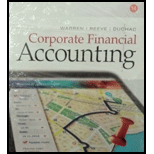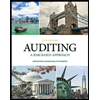
Internal Control: Internal control refers to the policies, and plans of the business organization along with other measures with a view to safeguard its assets, encourage the employees to adhere to the plans, to improve on the operational efficiency, and to ensure correct and reliable accounting information. Internal control is a process which ensures continuous reliability of accomplishment of a company’s objectives, related to operations, financial reporting, and in conformity with laws and regulations. The following are the some of the internal control procedures:
- Competent personnel, rotating duties, and mandatory vacations
- Separating responsibilities for related operations
- Separating operations, custody of assets, and accounting
- Proofs and security measures
To state: The general internal control weakness contributed to the fraud.
Want to see the full answer?
Check out a sample textbook solution
Chapter 7 Solutions
Bundle: Corporate Financial Accounting, Loose-leaf Version, 14th + LMS Integrated for CengageNOWv2, 1 term Printed Access Card
- Question: Skyline Enterprises has an average collection period of 25 days. Its average daily investment in receivables is $95,000. What is the receivables turnover?arrow_forwardPlease explain the solution to this financial accounting problem with accurate explanations.arrow_forwardPlease provide the accurate answer to this general accounting problem using appropriate methods.arrow_forward
- Do fast answer of this general accounting questionarrow_forwardSolve this Accounting problemarrow_forwardSheinberg Industries reported 2023 sales ($ in millions) of $6,842 and a cost of goods sold of $5,120. The company uses the LIFO method for inventory valuation. It discloses that if the FIFO inventory valuation method had been used, inventories would have been $89.6 million and $73.2 million higher in 2023 and 2022, respectively. If Sheinberg used the FIFO method exclusively, it would have reported 2023 gross profit closest to? a. $1,110.5 million b. $1,319.1 million c. $1,738.4 millionarrow_forward
- What would be the balance of the ending work in process inventory account?arrow_forwardI am searching for the correct answer to this financial accounting problem with proper accounting rules.arrow_forwardI am trying to find the accurate solution to this general accounting problem with appropriate explanations.arrow_forward
- I need guidance with this general accounting problem using the right accounting principles.arrow_forwardThe Dortmund Company uses the weighted-average method in its process costing system. The company's ending work in process inventory consists of 18,500 units. The ending work in process inventory is 100% complete with respect to materials and 60% complete with respect to labor and overhead. If the costs per equivalent unit for the period are $5.20 for materials and $4.10 for labor and overhead, what would be the balance of the ending work in process inventory account? (Do not round cost per equivalent unit) A. $142,265 B. $96,200 C. $141,710 D. $106,745arrow_forwardGiven the following information how much raw material was transferred to work in progress on March 31? Inventory on March 1 is $420,000, raw materials purchased in March are $780,000, and raw materials inventory on March 31 is $310,000. A: $890,000 B: $940,000 C: $750,000 D: $1,040,000arrow_forward
 Financial And Managerial AccountingAccountingISBN:9781337902663Author:WARREN, Carl S.Publisher:Cengage Learning,
Financial And Managerial AccountingAccountingISBN:9781337902663Author:WARREN, Carl S.Publisher:Cengage Learning, College Accounting, Chapters 1-27AccountingISBN:9781337794756Author:HEINTZ, James A.Publisher:Cengage Learning,Principles of Accounting Volume 1AccountingISBN:9781947172685Author:OpenStaxPublisher:OpenStax College
College Accounting, Chapters 1-27AccountingISBN:9781337794756Author:HEINTZ, James A.Publisher:Cengage Learning,Principles of Accounting Volume 1AccountingISBN:9781947172685Author:OpenStaxPublisher:OpenStax College Auditing: A Risk Based-Approach (MindTap Course L...AccountingISBN:9781337619455Author:Karla M Johnstone, Audrey A. Gramling, Larry E. RittenbergPublisher:Cengage Learning
Auditing: A Risk Based-Approach (MindTap Course L...AccountingISBN:9781337619455Author:Karla M Johnstone, Audrey A. Gramling, Larry E. RittenbergPublisher:Cengage Learning



